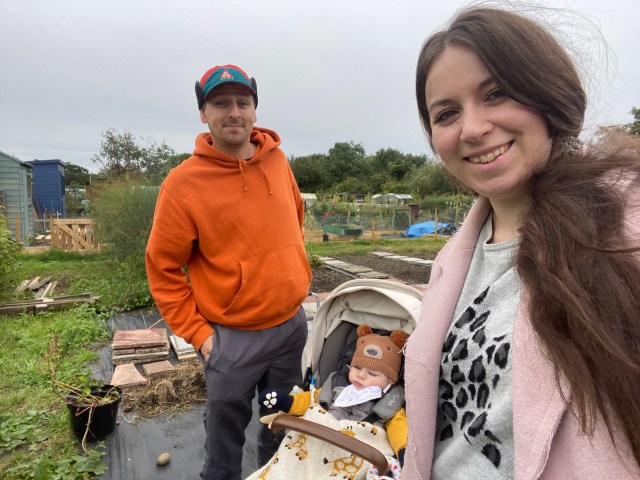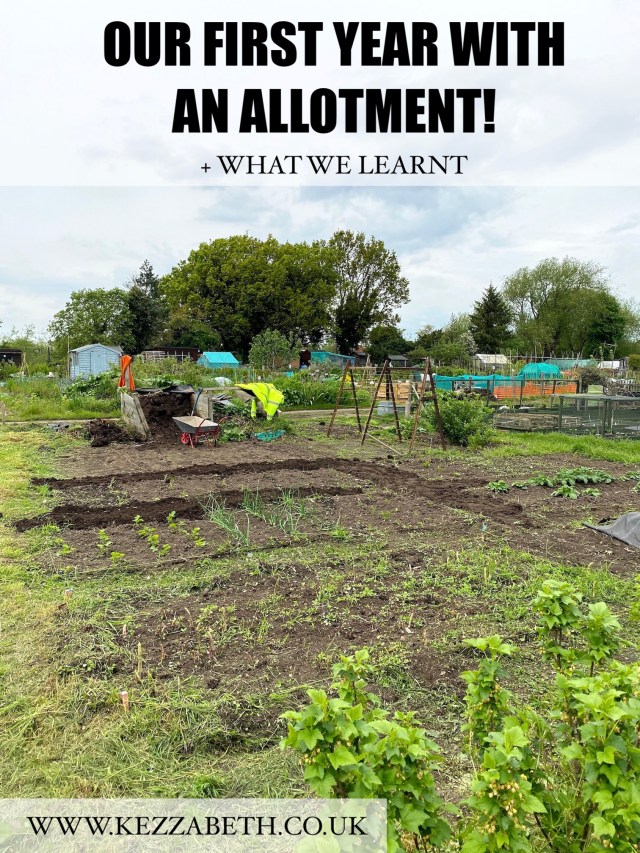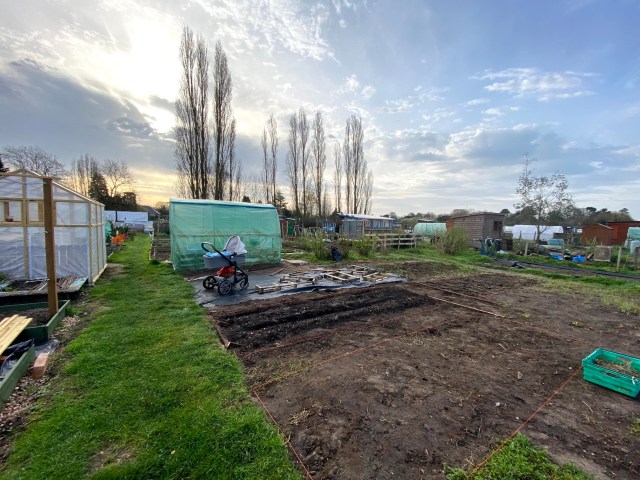It’s been an entire year since we took ownership of our allotment plot – and what a crazy fast year it’s been! We knew having an allotment was going to be a challenge, being complete novices to growing fruit and veg and not forgetting the fact we also had a newborn on our hands too! But now we’ve completed our first full year, I thought I’d share a little bit about what we’ve learnt so far and what having an allotment is really like.
Taking a little step back though, here’s a reminder of how the plot looked when we took it on in July last year (2020):
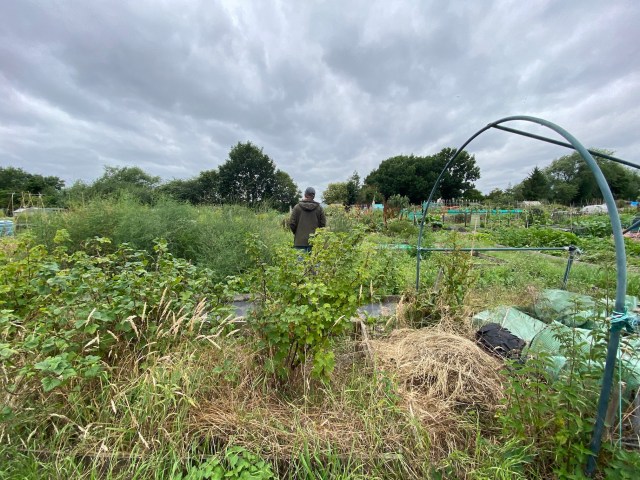
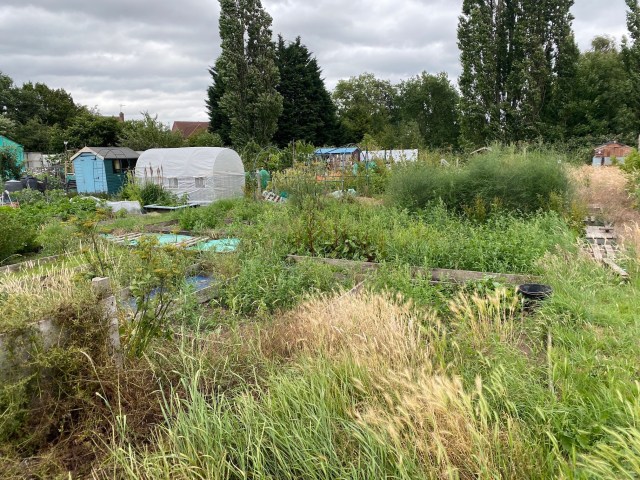
When we took the plot on, it had been abandoned for some time and was completely covered in weeds. There was also a lot of rubbish on the plot, old carpet, rotten wood, tons of plastic (ugh!), a broken poly-tunnel, you name it.
We spent a good 4-6weeks last autumn clearing the plot and then we covered it using some heavy-duty landscaping fabric to keep the area weed-free for the next several months, so we could start our growing journey properly this spring. You can see more photos and read more about everything we did to our allotment plot last year here.
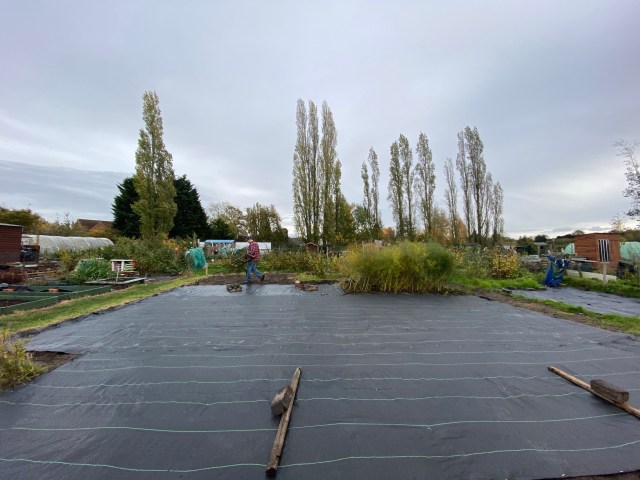
When spring arrived, we slowly started to get to work. Grant spent some time setting up a poly-tunnel (we planned to use this mostly for storage as it was MUCH cheaper than buying a shed and unfortunately hadn’t managed to find one secondhand) and I started sowing seeds in the conservatory.
When it was warm enough, we uncovered the landscaping fabric and started marking out our vegetable beds using a string line and some pegs (photo below). As we were on a budget, we felt this was a better option for us rather than building beds which we really couldn’t afford with the high price of wood at the moment. Our ‘string beds’ worked to some degree and I think would be a good option for testing layouts BEFORE building any beds – but a string line alone definitely wouldn’t work for us in the long term and we still plan to eventually build some beds.
After our ‘beds’ were done, we started to plant our crop out. I suppose this is where the real challenge began! We lost a fair amount of crops (peas, sprouts, and carrots were completely wiped out!), we struggled to keep the weeds at bay and we also struggled to find time to overhaul and re-design the plot in such a way to make it as low-maintenance as possible. Things like creating paths, so we didn’t need to de-weed as much would have been INCREDIBLY useful, but with a very young baby, time to do all these things just wasn’t on my side.
We did have some great successes too though. We kept the asparagus we inherited with the plot alive and DAMN it tasted good! We also grew lots of sweetcorn which WASN’T eaten by rats (apparently a real problem at our allotment site!) and we had bags and bags of potatoes, courgettes, and beans. In fact, you could say we had a little too much.
All in all, it was not a bad first year I’d say. And we learnt A LOT!
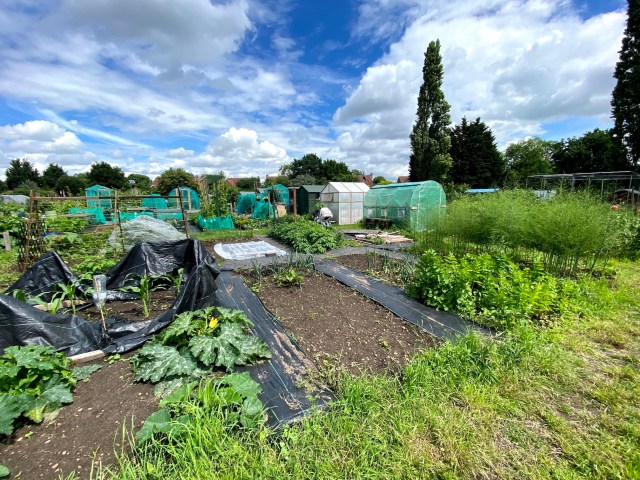
Our First Year With an Allotment: What We’ve Learnt!
Maintaining an Allotment Takes SO MUCH TIME
Having an allotment really does take SO MUCH time. No, it really does. I never expected having an allotment plot to be quick or easy in any way, but it’s still a lot more work than perhaps I initially imagined.
The weeds at our allotment grow FAST. Our garden at home is relatively weed-free and those that do grow, are slow. At the allotment, weeds THRIVE! New weeds appear daily and they grow like mad. If you’re not keeping on top of them, they take over really quickly.
Most people at our allotment site say they need to come down a minimum of 2 days a week to keep on top of everything – that’s not just weeding either. Having an allotment is definitely a hobby that requires a lot of free time.
You can see how quickly our ‘paths’ turned to weeds below in a matter of weeks.
Watering an Allotment is a CHORE
Even things like watering is a job and a half. We’re very fortunate as we have access to water at our allotment site (I know some locations have nothing at all!) and our plot is also quite close to the water point too. However, even though we are one of the closest plots to the water – going back and forth to refill the watering can, really does take quite some time! In summer, we needed to come down every other day to water, so watering can really become quite a commitment on its own.
Pests Eat EVERYTHING
Okay so I’m being a bit dramatic, but yes, your crop will get eaten! Obviously, we knew lettuces would be eaten by rabbits and so on, but birds will attack certain crops in their young seedling stage and even things like rats can be a problem too.
We only had 2 mesh covers when we began growing, so not covering enough of our crop was possibly one of our biggest initial mistakes. Next year, we’ll be covering a lot more of our crops for sure!
Coverings Need to Be Easy-to-Remove
Grant built a frame for our beans and covered it in netting, but in such a way so that the netting couldn’t easily be removed and meant we couldn’t get access to de-weed. I did point this out to Grant at the time he was covering it, but he assured me it wasn’t such a problem. Nope, it was a problem.
Some plots use large ‘cages’ that can easily be taken on/off crops – but this seems to only work if you have somewhere to move the cage to. A simple net placed over bamboo sticks and weighed down seems to be the most popular option, taking up less space when not in use and easy to remove/recover – so we’ll probably do more of this next year.
Sowing Seeds Directly Into the Ground
Another big mistake we made was not marking out the areas where we’d sowed seeds directly into the ground well enough. It’s a fairly rare occasion to find BOTH Grant and me on the plot at the same time. Often I would pop down and do some work then a few days later Grant would pop down.
On more than 1 occasion, I’d sowed seeds directly into the ground and added some short bamboo sticks to show where these rows of seeds were. Whether it was forgetfulness or ignorance, the site of my sowed seeds ended up being either trampled or hoed over, removing any growth.
At this point I should say, we didn’t have any beds or paths marked out, so the whole area was just soil – and quite frankly we found that really hard to properly navigate. Having a defined path, in the end, stopped up trampling our own crops, but next year, I still think we need to mark out the areas where we’ve sowed seeds into the ground, in a better and more obvious way.
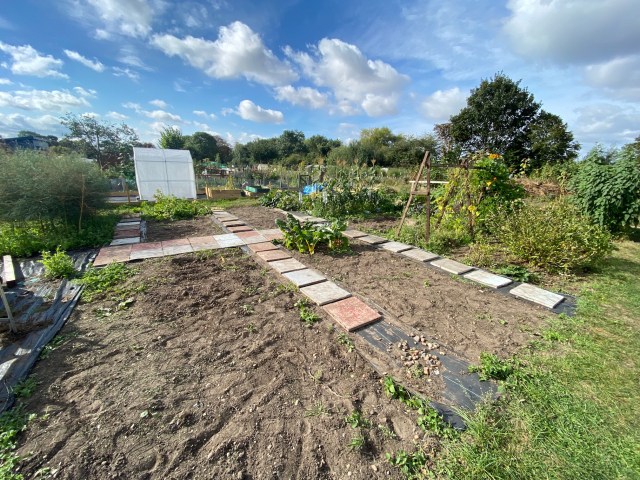
12 is NOT the magic number
I mean, nobody ever said 12 was the magic number. Being complete notices at growing fruit/veg, I had no idea how many of each crop we would need/want. So I just did 12. Of everything. Turns out 12 courgettes is absolutely ridiculous unless you’re feeding a family of 100. And 12 onions isn’t exactly going to last long.
I think we now have a better idea of what we need and how much fruit/veg you can get from one plant. I’m sure getting those numbers exactly right is still going to be a learning curve for us for some time, but I imagine this is probably an unavoidable lesson to learn for most people – you’ll almost always have too much of one thing and not enough of another. Experience can only teach you the perfect numbers I guess.
Having an Allotment is Incredibly Social!
I obviously expected to chat to our allotment neighbours, but actually, you end up chatting to EVERYONE! I wouldn’t say our allotment site is small either. There really is a great community – people wave as they come/go, everyone is keen to lend a hand (or tool!), or offer advice when needed and we’ve even been given a few plants too.
Being on maternity leave and generally not seeing many people or going anywhere, I have thoroughly enjoyed just CHATTING to people at the allotments. Everyone is so friendly, and it makes a really lovely vibe!
The negative to the social aspect, is that this in itself could prevent us from getting so much done. Sometimes I’d just need to quickly get IN-and-OUT and I’d stop for a quick hello which would turn into a 20-min chat and before I knew it, I had to ditch my allotment plans, quickly water as much as I could and leave as fast as I could. I guess this is probably my own fault though!
Allotment Life With a Baby – It’s a Challenge!
This one is probably pretty obvious, but I’m going to mention it anyway.
In those early newborn days, Dylan slept like an angel at the allotment and we got SO much done. As we started to get into a slight sleep/feeding routine, I’d pop him in the pram for a nap, walk to the allotment and get tons of work, it was amazing.
But somewhere between 4-5months any outdoor noise seemed to wake him and pram naps just didn’t work, I’d spend all my time rocking the pram with a grumpy baby who’d randomly woken up from the tweet of a bird in the distance. So I stopped going to the allotment during nap time. But at the same time, I also didn’t want to go when he was awake either, as I’d feel bad with him just being sat in the pram and as you’d expect, he would get grizzly fairly quick without your full attention occupying him.
So for a good 3 months or so (somewhere between ages 5-7 months), I was unable to do very much at all. It just wasn’t possible to de-weed/sow/do any proper work on the plot, so the only thing I managed was a daily walk to water before bedtime.
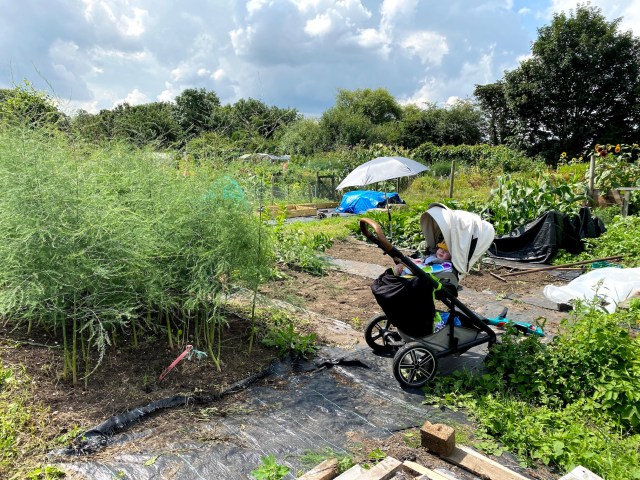
Dylan is now 9 months (where are the months going?!) and he now sleeps really well outdoors in his pram again, so I’ve been able to get a little more done again in the last couple of months. But the future is unpredictable and who knows how things will be in a few months from now!
Despite Everything, “Life Finds a Way”
Like the great Jurassic Park quote, despite some inconsistent care for our crop, it still managed to find a way to survive. We didn’t offer nearly enough tomato feed to our tomatoes or trim the plants nearly enough. We left our polytunnel unwatered during an incredibly hot period for more days than I’d have liked and nothing we did was perfect. But, despite all our growing mistakes, many our fruit and vegetables still survived. I’m sure we could have got MORE crop, or BETTER crop had we done things differently, but what I’m trying to say is, despite our imperfect approach, life somehow finds a way to keep going. You can make all the mistakes and chances are, you’ll still get something at the end.
Our First Year Growing with an Allotment – Overall a Success
So as I said, we weren’t successful with everything we grew this year – we lost ALL the peas, ALL the sprouts, and ALL the carrots. But we did really well with others – leeks, sweetcorn, and potatoes. Others we had hit/miss success – the onions grew beautifully but some rotted at the very end.
It’s definitely been a learning curve! We’ve learnt when to sow seeds for each plant, when to harvest, the types of problems each plant encounters etc, but there is still MUCH more for us to learn and of course the problems we have next year may be completely different to this years.
Despite losing a fair amount of crops and having mixed success with others, we were still really happy with what we did produce. I mean, we could have come out with nothing and that would have been a real disaster!
Our Plans for Next Year
Unfortunately, we hadn’t been able to get as much work done to our plot as we’d have liked this year. We had originally planned to build some beds, but the crazy cost of timber held up back on that. Recently we’ve managed to find some secondhand/leftover wood to use as beds, but just haven’t had the time to build anything, so that’s on next year’s to-do list.
We’ve also recently picked up some free pavers locally, but they’ve all got massive globs of mortar on the bottom which need removing so they can sit flat on the ground. And, we also want to redesign the front section of our allotment, which we didn’t use at all this year.
So basically, lots to do, as always! I’m looking forward to next year though – I think we’ve learnt a lot and will be better prepared in many ways, although, it’s going to be VERY different with a TODDLER running around and I don’t think we can prepare for that!!
Anyway, I hope this shared some of the realities we faced on our first year with an allotment and perhaps a few things to expect if you’re signing up for one. Any tips/advice are always welcome – as I say, we’re VERY new to all this and still have A LOT to learn!
And if you want to follow our allotment journey in real-time, don’t forget you check us out on Instagram at @kezzabeth_blog too!
